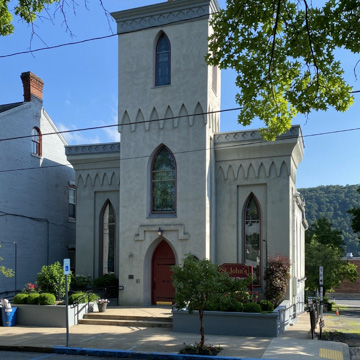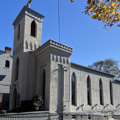This stuccoed brick church is dominated by a square central tower flanked by flat-roofed wings with elongated lancet windows. It is a hybrid style with Egyptian Revival massing and cornice and Gothic Revival windows, entrance, and blind arcade. Its mid-1840s building date places it after two famous John Haviland buildings in Philadelphia, the Eastern State Penitentiary (1821–1836), with lancet windows and square castellated towers, and his Pennsylvania Fire Insurance Company (1838) in the Egyptian Revival mode. Add to this, Thomas U. Walter's Egyptian Revival debtor's wing of the Philadelphia County Prison (1835), and it is likely that Charles Callahan was looking to Philadelphia for his inspiration. The church has massing similar to the county jails of Ebensburg ( CA3), Clarion ( CL2), and Hollidaysburg ( BL3), two of which (Ebensburg and Hollidaysburg) were designed by Edward Haviland, John's son.
You are here
St. John's Episcopal Church
If SAH Archipedia has been useful to you, please consider supporting it.
SAH Archipedia tells the story of the United States through its buildings, landscapes, and cities. This freely available resource empowers the public with authoritative knowledge that deepens their understanding and appreciation of the built environment. But the Society of Architectural Historians, which created SAH Archipedia with University of Virginia Press, needs your support to maintain the high-caliber research, writing, photography, cartography, editing, design, and programming that make SAH Archipedia a trusted online resource available to all who value the history of place, heritage tourism, and learning.


















